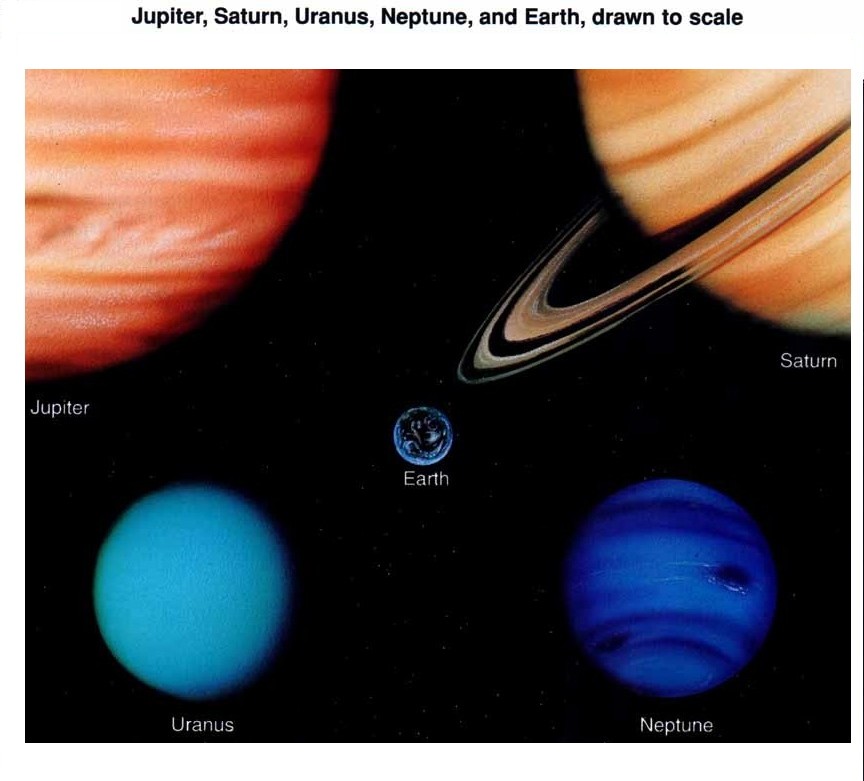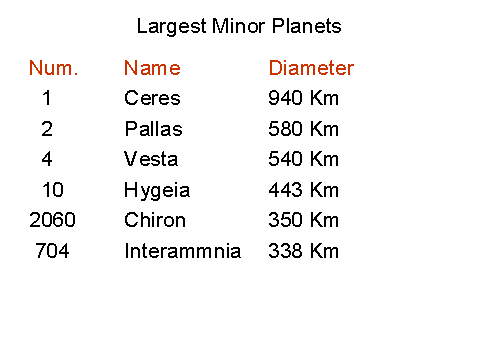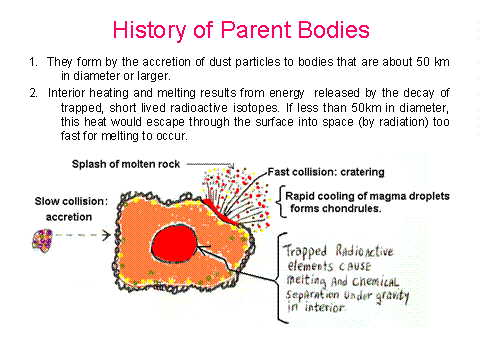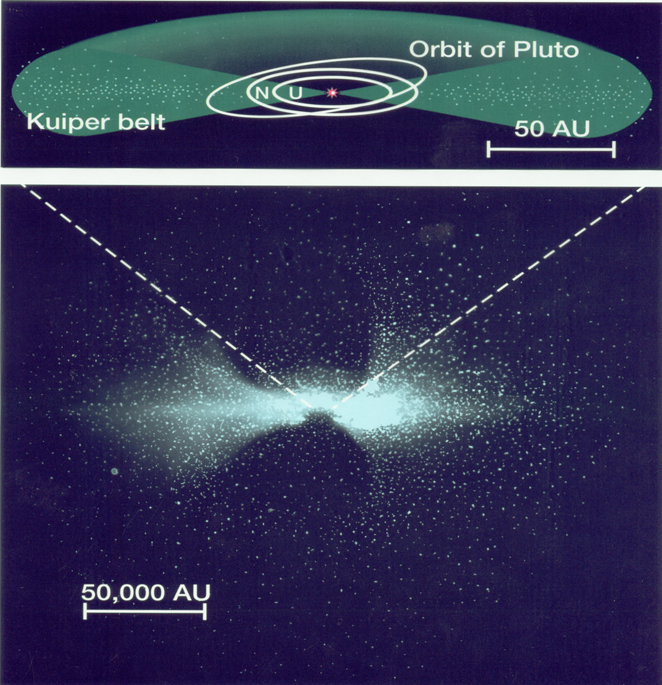in the textbook.)
mountains. The surface temperature on the sunlit side is > 600 F.
Density: Highest of the planets.
Interior: Relatively
cool; no molten rock; large dense core of iron and other heavy metals.
Since
Mercury appears to have a weak magnetic field, their must be a central
kernal in the core
that is molten metal.
Satellites: none
VENUS
Atmosphere: Composed
mainly of carbon dioxide (CO2), N2, sulfur dioxide
(SO2), hydrogen sulfide (H2S),
and sulfur dust. Dense clouds
of sulfuric acid droplets and sulfur dust perpetually shroud the surface.
There are
traces of water
vapor.
Surface: Atmospheric
pressure is 90 times greater than the sea level pressure on Earth. The
surface temperature
is about 800 F. Very
high- speed winds blow continuously. Radar surveys from Earth and orbiting
satellites
have revealed several mountain
ranges, volcanic cones, and many large, eroded craters. There is evidence
of
volcanic activity and crustal
movements (plate tectonics).
Density: Less than Mercury but greater than Earth.
Interior: Still molten, thereby providing volcanism and plate tectonics.
Satellites: none
MARS
Atmosphere: Very low
density; surface pressure too low to support human life. Composed mostly
of CO2
and N2.
Occasional thin clouds of
ice crystals. There are occasional dust storms that blur the surface features
as seen
from the Earth.
caps consisting of a thin layer of water ice and frozen carbon dioxide. Many shallow craters discovered in 1965 by
Mariner IV fly-by, but these are fewer per unit area than on the Moon. Several extinct volcanoes, including the
largest volcano in the Solar System: Mons Olympia (600 km by 25 km), and the largest canyon: Valles Marineris
(4000 km x 250 km x 6 km). The latter is believed to be a fault in the crust.
Satellites: Phobus
and Deimos, two small, irregularly shaped, rocky bodies averaging 22 km
and 12 km in
diameter. Both are
heavily cratered.
JUPITER
Atmosphere: Very cold,
dense, and deep. It comprises a large fraction of the diameter of the planet.
One
observes only the tops of
variegated cloud bands that are parallel to the equator. Numerous vortices,
e
specially in the polar regions.
A very large, red colored, hurricane-like structure has existed for the
last few
hundred years.
Interior: Unknown,
but probably various layers of ice and perhaps a solid core about the size
of Earth. Overall
density is comparable to
liquid water on Earth.
Satellites: 62, not
counting the more than 250 very small objects revolving beyond the orbit
of Callisto. The
four largest, Ganymede,
Callisto, Europa, and Io were discovered by Galileo in 1609 and are called
the Galilean
satellites. Io has
the greatest number (7) of active volcanoes in solar system. These
exude sulfur dioxide gas
and molten sulfur.
The other 3 Galilean moons have ice in their crusts. All moons have
craters similar to those
seen on Mars.
Rings: Several, thin, concentric rings, comprised of many dark, kilometer-sized and smaller bodies.
SATURN
Atmosphere: Similar
to Jupiter, but colder. The lower temperature results in a helium haze
that partly obscures
the cloud bands
Interior: Unknown, but similar to Jupiter.
Satellites: 61. Titan is
the largest and has an atmosphere of ammonia and methane. Most have ice
incorporated
into their surfaces and
have layers of ice in the interior. All have cratered surfaces.
Rings: Comprised of millions
of small, ice-covered bodies that move in various, relatively thin, concentric
bands in the plane of Saturn's
equator. They are noticeable in a small telescope.
URANUS
Atmosphere: It gives a distinctive
greenish appearance to the planet. Comprised mostly of hydrogen, helium,
methane and some ammonia.
Faint cloudbursts have been photographed by the Voyager II spacecraft.
The
cloud belts are more conspicuous
in the polar regions.
Interior: Unknown but low in density.
Satellites: 27, 8 of which
were discoverd by Voyger 2 in 1986. Also 8, well separated, sparse
rings of small
bodies. Ice is an important
component in the structure of all satellites, which are heavily cratered.
NEPTUNE
Voyager 2 images reveal a
dark blue (due to methane) atmosphere with thin bands of white clouds.
According
to a NASA website, the white
cloud bands seen in the Voyager 2 images are comprised of methane crystals.
There are also several large,
storm-like vortices. The largest is a dark blue vortex that may be similar
in nature
to Jupiter's great red spot.
There is also a smaller vortex that resembles a human eye.
There are 13, heavily cratered
satellites, 6 of which were discovered by Voyager 2 in 1989. The
satellites have
a large proportion of various
ices in their composition. The largest is Triton, which has erupting geysers
of
various gases. This activity
is caused by internal heating as a result if tidal interactions with Neptune.
PLUTO
Pluto once had the distinction
of being the smallest major planet, but it is now classified as a dwarf
planet.
Recent measurements indicate
the planet is composed of 70% rock and 30% ices. Most of the ices comprises
a thick upper layer with
embedded rocky particles. Pluto has 5 moons; Charon is its largest satellite
and is
1/3 the size of Pluto. It
contains even more ice. Two other very small satellites were discovered
in 2006.
No space probes have visited
this planet. Most new information has been obtained with the Hubble
Space-telescope.

Above montage courtesy of NASA.
3. The
surfaces of the terrestrial planetary bodies, moons, and minor planets
(asteroids) are cratered to
various degrees depending on how much erosion has occurred since
the body formed.
3.
Mercury and the Moon have have surfaces covered with numerous craters of
various sizes and ages.
There are slso numerous rills, rays, ridges amd mountins.
surfaces dating back more than 4.5 billion years.
5. All the other planetary moons have cratering, even those whose surfaces are mostly ice.
6. The
surface of Mars shows signs of erosion, since the craters are fewer and
shallower. Many extinct volcanic
cones remain intact including
the largest known volcanic cone in the solar system, Mons Olympus.
7. Radar
surveys of the Venusian surface reveal large shallow craters, mountainous
regions, and some volcanic
cones,some of which appear
to be active.
surface every million years or so. The Earth's surface changes over completely every few hundred million years
as a result of erosion, mountain building, and volcanic activity. The Earth has only a few meteorite impact craters.
The youngest is about 35,000 years old and the oldest remnant of an impact crater is some 210 million years old.
9. It has
been concluded that when the planets were forming about 4.55 billion years
ago, there was an intense
meteorite bombardment going on for all the planets. In fact, this bombardment
was part of the accretion
process of planetary growth.
10 Accretion
is growth by addition. The great meteorite bombardment essentially ended
about 3.5 billion years
ago, since the lunar maria have only small, young craters.
11. All
planetary bodies less than about 300 km in diameter are irregular in shape
rather than spherical or round.
This is a consequence of (a) the small mass, and hence, weak surface gravities
of these objects, and
(b) the fact that these bodies formed cold by random collisions and
were never completely molten.
12. The Earth has only
a few meteorite impact craters. The youngest is about 35,000 years
old and is located
in the desert of Arizona. Yhe oldest remnant of an impact crater
is about 250 million years old and is
located in northeast Canada.
The minor planets (often called asteroids or planetoids) are relatively
small planetary bodies less than
1000 km in diameter.

of 2.8 AU from the Sun. The diagram below shows the asteroid belt and its position relative the planets. The white
and green dots represent the approximate locations of the 400,000 known asteroids.
Objects smaller than 300
km in diameter are irregular in shape, whereas objects that are larger
than 300 km in
diameter tend to be more
nearly spheroidal in shape, like the Earth. This is a consequence
of two factors that
result from the mass of
the body: (1) the amount of heating the body underwent after it was
formed, and
(2) the surface gravity
of the body which could be sufficiently strong for it to overcome rigid
body forces and
therefore become spheroidal.
in shape.
With regard
to item (1) above: More massive and therefore larger bodies underwent total
surface melting as a
result of an enhanced accretion
process. This allowed gravity to form a more spherical shape.
Less massive
bodies were never heated
to the degree that they become totally molten.
The rotation
of a body also influences its shape. The faster it rotates,
the more oblate it is. Even the Earth is
not perfectly spheroidal
in shape but is somewhat oblate.
Space
probes have been able to telemeter images of the surfaces of some
minor planets. These have
shown that the minor planets
also have many impact craters.


